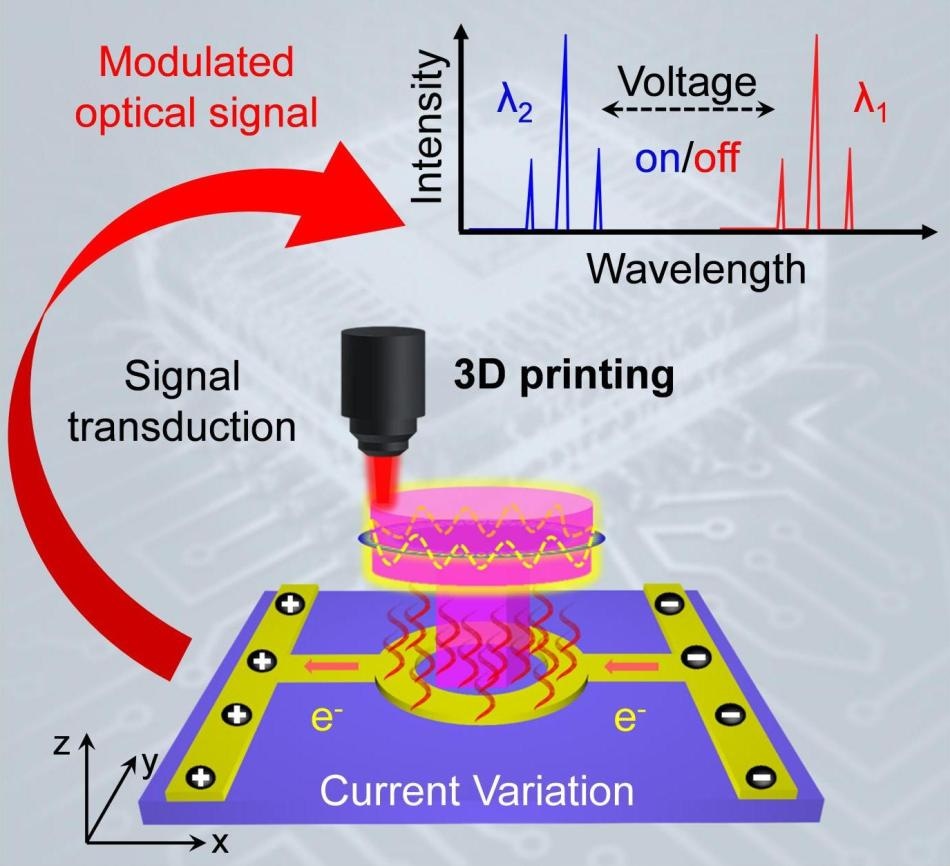 By Sabina AliJun 14 2019
By Sabina AliJun 14 2019Optoelectronic integration provides a potential approach to gain the benefits of both electrons and photons at the same time when they act as information carriers, including high-speed information processing and high-density communication, opening the door for next-generation integrated circuits (ICs).
 Schematic illustration of an integrated electrically controlled microlaser module for optoelectronic hybrid integration. Briefly, this module is designed to be a thermo-responsive polymer resonator on top of a chip-scale metal heating circuit. The voltage is applied in-plane with the current transport to provide local-area thermal field, which induces the lasing wavelength change of the upper dye-doped microresonators. (Image credit: Science China Press)
Schematic illustration of an integrated electrically controlled microlaser module for optoelectronic hybrid integration. Briefly, this module is designed to be a thermo-responsive polymer resonator on top of a chip-scale metal heating circuit. The voltage is applied in-plane with the current transport to provide local-area thermal field, which induces the lasing wavelength change of the upper dye-doped microresonators. (Image credit: Science China Press)
Due to the growing demand on bandwidth and information density in ICs, there is a need for the micro/nano functional devices that can be fabricated in three-dimensional (3D) ICs, which are popular for their enhanced performance in data processing under lower consumption.
However, in such highly integrated circuits, selective electrical modulation of particular micro/nanoscale optical devices, such as waveguides and light sources, is a major requirement for producing more compact and more functional integrated elements. But this is obstructed by the commonly used nonlinearity present in electro-optic materials.
Femtosecond laser direct writing (FsLDW), when used as one of the 3D printing methods, allows the direct and addressable production of 3D-integrated optoelectronic devices making use of organic compounds with two-photon polymerized features. The doping flexibility allows the polymerized microstructures to be readily integrated with organic dye molecules to make functional devices, such as coherent laser sources.
In addition, organic polymers show outstanding responsiveness to external stimuli, for example, temperature. Due to their substantial thermo-optic coefficient, the electrical tuning of resonant wavelength with high efficiency can be achieved when they are fabricated into microcavity structures. The integration of thermo-responsive polymeric microlaser with underneath electrical microheater in the 3D fabrication way can be used as an effective hybrid microlaser module with selective electric modulation toward optical-electronic integration.
Most recently, Professor Yong Sheng Zhao’s team in the Institute of Chemistry, Chinese Academy of Sciences presented an in situ electrically modulated microlaser module based on 3D-printed dye-doped polymeric microdisks, which is reported in Science China Chemistry.
With the thermo-optic effect of the polymer matrix, the lasing modes could be adjusted from the microdisk by heating. The designability of the shape of FsLDW enables the fabrication of higher-level microstructures to control light signals, including the coupled double-microdisk resonators for laser mode selection and the waveguide-coupled microdisks for light remote control. The former microstructure was further incorporated with an underneath electrical microheater.
Therefore, the cavity resonant wavelength can be altered based on the variation in the resistance heating controlled optical length through the thermo-optic effect of the polymeric matrix material, which allowed an electrical modulation of the output wavelength of the 3D-printed microlaser module.
This research was funded by the Ministry of Science and Technology of China (Grant No. 2017YFA0204502) and the National Natural Science Foundation of China (Grant Nos. 21533013 and 21790364).